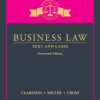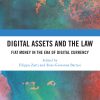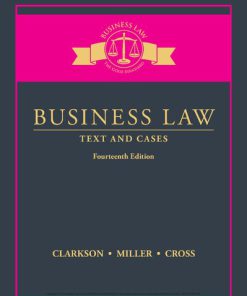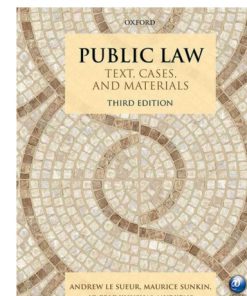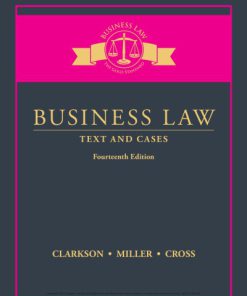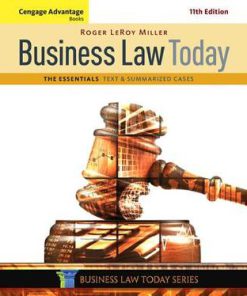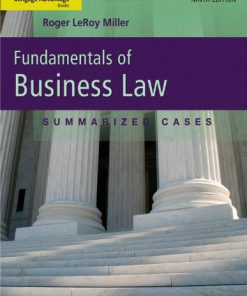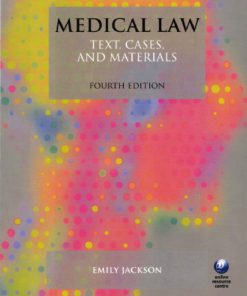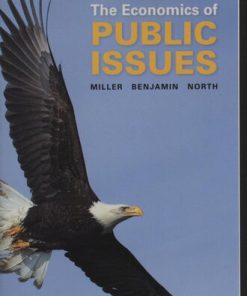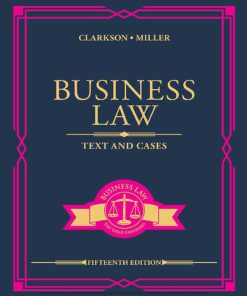Business Law Today Text Summarized Cases 11th Edition by Roger Leroy Miller 1305644522 9781305644526
$50.00 Original price was: $50.00.$25.00Current price is: $25.00.
Business Law Today Text Summarized Cases 11th Edition by Roger Leroy Miller – Ebook PDF Instant Download/DeliveryISBN: 1305644522, 9781305644526
Full download Business Law Today Text Summarized Cases 11th Edition after payment.
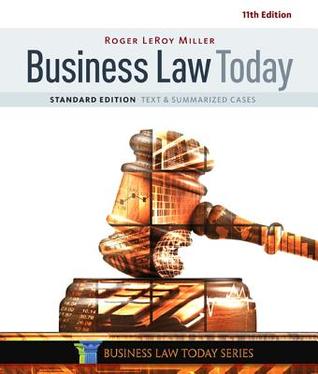
Product details:
ISBN-10 : 1305644522
ISBN-13 : 9781305644526
Author: Roger Leroy Miller
Interesting, clear, and applied, BUSINESS LAW TODAY: STANDARD EDITION, 11E is the ideal guide to the law and what it means in the business world –- from contracts and secured transactions to warranties and government regulations. Easy to understand with an engaging writing style that is matched by vibrant visuals, BUSINESS LAW TODAY: STANDARD EDITION covers contemporary topics that impact not only the business world, but also your life. You examine the financial crisis and its impact on business law, identity theft, immigration law, and diversity issues. Fascinating features and intriguing cases highlight the practicality of the concepts you are learning. In addition, numerous learning support resources provide tools that address various learning styles.
Business Law Today Text Summarized Cases 11th Table of contents:
Unit 1. The Legal Environment of Business
Chapter 1. The Legal Environment
1–1. Business Activities and the Legal Environment
1–1a. Many Different Laws May Affect a Single Business Transaction
1–1b. Linking Business Law to the Six Functional Fields of Business
1–1c. The Role of the Law in a Small Business
1–2. Sources of American Law
1–2a. Constitutional Law
1–2b. Statutory Law
1–2c. Administrative Law
1–2d. Case Law and Common Law Doctrines
1–3. Common Law Tradition
1–3a. Early English Courts
1–3b. Stare Decisis
1–3c. Equitable Remedies and Courts of Equity
1–3d. Schools of Legal Thought
1–4. Classifications of Law
1–4a. Civil Law and Criminal Law
1–4b. National and International Law
Reviewing … The Legal Environment
Linking Business Law to Corporate Management. Dealing with Administrative Law
Key Terms
Chapter Summary: The Legal Environment
Issue Spotters
Learning Objectives Check
Business Scenarios and Case Problems
Critical Thinking and Writing Assignments
Appendix to Chapter 1
Chapter 2. Constitutional Law
2–1. The Constitutional Powers of Government
2–1a. A Federal Form of Government
2–1b. The Separation of Powers
2–1c. The Commerce Clause
2–1d. The Supremacy Clause
2–2. Business and the Bill of Rights
2–2a. Limits on Federal and State Governmental Actions
2–2b. The First Amendment—Freedom of Speech
2–2c. The First Amendment—Freedom of Religion
2–3. Due Process and Equal Protection
2–3a. Due Process
2–3b. Equal Protection
2–4. Privacy Rights
2–4a. Federal Privacy Legislation
2–4b. The USA Patriot Act
Reviewing … Constitutional Law
Business Application. Is “Pretexting” Illegal?
Key Terms
Chapter Summary: Constitutional Law
Issue Spotters
Learning Objectives Check
Business Scenarios and Case Problems
Critical Thinking and Writing Assignments
Chapter 3. Courts and Alternative Dispute Resolution
3–1. The Judiciary’s Role in American Government
3–1a. Judicial Review
3–1b. The Origins of Judicial Review in the United States
3–2. Basic Judicial Requirements
3–2a. Jurisdiction
3–2b. Jurisdiction in Cyberspace
3–2c. Venue
3–2d. Standing to Sue
3–3. The State and Federal Court Systems
3–3a. The State Court Systems
3–3b. The Federal Court System
3–4. Following a State Court Case
3–4a. The Pleadings
3–4b. Pretrial Motions
3–4c. Discovery
3–4d. Pretrial Conference
3–4e. Jury Selection
3–4f. At the Trial
3–4g. Posttrial Motions
3–4h. The Appeal
3–4i. Enforcing the Judgment
3–5. Courts Online
3–5a. Electronic Filing
3–5b. Cyber Courts and Proceedings
3–6. Alternative Dispute Resolution
3–6a. Negotiation
3–6b. Mediation
3–6c. Arbitration
3–6d. Other Types of ADR
3–6e. Providers of ADR Services
3–6f. Online Dispute Resolution
Reviewing … Courts and Alternative Dispute Resolution
Key Terms
Chapter Summary: Courts and Alternative Dispute Resolution
Issue Spotters
Learning Objectives Check
Business Scenarios and Case Problems
Critical Thinking and Writing Assignments
Chapter 4. Tort Law
4–1. The Basis of Tort Law
4–1a. The Purpose of Tort Law
4–1b. Damages Available in Tort Actions
4–1c. Tort Reform
4–1d. Classifications of Torts
4–1e. Defenses
4–2. Intentional Torts against Persons
4–2a. Assault and Battery
4–2b. False Imprisonment
4–2c. Intentional Infliction of Emotional Distress
4–2d. Defamation
4–2e. Invasion of the Right to Privacy and Appropriation
4–2f. Fraudulent Misrepresentation
4–2g. Abusive or Frivolous Litigation
4–2h. Wrongful Interference
4–3. Intentional Torts against Property
4–3a. Trespass to Land
4–3b. Trespass to Personal Property
4–3c. Conversion
4–3d. Disparagement of Property
4–4. Unintentional Torts (Negligence)
4–4a. The Duty of Care and Its Breach
4–4b. Causation
4–4c. The Injury Requirement and Damages
4–4d. Defenses to Negligence
4–4e. Special Negligence Doctrines and Statutes
4–5. Strict Liability
4–5a. Abnormally Dangerous Activities
4–5b. Other Applications of Strict Liability
Reviewing … Tort Law
Business Application. How Important Is Tort Liability to Business?
Key Terms
Chapter Summary: Tort Law
Issue Spotters
Learning Objectives Check
Business Scenarios and Case Problems
Critical Thinking and Writing Assignments
Chapter 5. Product Liability
5–1. Product Liability
5–1a. Negligence
5–1b. Misrepresentation
5–2. Strict Product Liability
5–2a. Strict Product Liability and Public Policy
5–2b. Requirements for Strict Product Liability
5–2c. Product Defects—Restatement (Third) of Torts
5–2d. Market-Share Liability
5–2e. Other Applications of Strict Liability
5–3. Defenses to Product Liability
5–3a. Preemption
5–3b. Assumption of Risk
5–3c. Product Misuse
5–3d. Comparative Negligence (Fault)
5–3e. Commonly Known Dangers
5–3f. Knowledgeable User
5–3g. Statutes of Limitations and Repose
Reviewing … Product Liability
Linking Business Law to Corporate Management. Quality Control
Key Terms
Chapter Summary: Product Liability
Issue Spotters
Learning Objectives Check
Business Scenarios and Case Problems
Critical Thinking and Writing Assignments
Chapter 6. Intellectual Property Rights
6–1. Trademarks
6–1a. Statutory Protection of Trademarks
6–1b. Trademark Registration
6–1c. Trademark Infringement
6–1d. Distinctiveness of the Mark
6–1e. Service, Certification, and Collective Marks
6–1f. Trade Dress
6–1g. Counterfeit Goods
6–1h. Trade Names
6–1i. Licensing
6–2. Patents
6–2a. Searchable Patent Databases
6–2b. What Is Patentable?
6–2c. Patent Infringement
6–2d. Remedies for Patent Infringement
6–3. Copyrights
6–3a. What Is Protected Expression?
6–3b. Copyright Infringement
6–3c. Copyright Protection for Software
6–4. Trade Secrets
6–4a. State and Federal Law on Trade Secrets
6–4b. Trade Secrets in Cyberspace
6–5. International Protections
6–5a. The Berne Convention
6–5b. The TRIPS Agreement
6–5c. The Madrid Protocol
6–5d. The Anti-Counterfeiting Trade Agreement
Reviewing … Intellectual Property Rights
Linking Business Law To Marketing. Trademarks and Service Marks
Key Terms
Chapter Summary: Intellectual Property Rights
Issue Spotters
Learning Objectives Check
Business Scenarios and Case Problems
Critical Thinking and Writing Assignments
Chapter 7. Internet Law, Social Media, and Privacy
7–1. Internet Law
7–1a. Spam
7–1b. Domain Names
7–1c. Cybersquatting
7–1d. Meta Tags
7–1e. Trademark Dilution in the Online World
7–1f. Licensing
7–2. Copyrights in Digital Information
7–2a. Copyright Infringement
7–2b. MP3 and File-Sharing Technology
7–3. Social Media
7–3a. Uses in the Legal Process
7–3b. The Electronic Communications Privacy Act
7–3c. Protection of Social Media Passwords
7–3d. Company-wide Social Media Networks
7–4. Online Defamation
7–4a. Identifying the Author of Online Defamation
7–4b. Liability of Internet Service Providers
7–5. Privacy
7–5a. Reasonable Expectation of Privacy
7–5b. Data Collection and Cookies
7–5c. Internet Companies’ Privacy Policies
7–5d. Protecting Consumer Privacy
Reviewing … Internet Law, Social Media, and Privacy
Key Terms
Chapter Summary: Internet Law, Social Media, and Privacy
Issue Spotters
Learning Objectives Check
Business Scenarios and Case Problems
Critical Thinking and Writing Assignments
Chapter 8. Criminal Law and Cyber Crime
8–1. Civil Law and Criminal Law
8–1a. Key Differences between Civil Law and Criminal Law
8–1b. Civil Liability for Criminal Acts
8–1c. Classification of Crimes
8–2. Criminal Liability
8–2a. The Criminal Act
8–2b. State of Mind
8–2c. Corporate Criminal Liability
8–3. Types of Crimes
8–3a. Violent Crime
8–3b. Property Crime
8–3c. Public Order Crime
8–3d. White-Collar Crime
8–3e. Organized Crime
8–4. Defenses to Criminal Liability
8–4a. Justifiable Use of Force
8–4b. Necessity
8–4c. Insanity
8–4d. Mistake
8–4e. Duress
8–4f. Entrapment
8–4g. Statute of Limitations
8–4h. Immunity
8–5. Constitutional Safeguards and Criminal Procedures
8–5a. Fourth Amendment Protections
8–5b. Fifth Amendment Protections
8–5c. Protections under the Sixth and Eighth Amendments
8–5d. The Exclusionary Rule and the Miranda Rule
8–5e. Criminal Process
8–5f. Federal Sentencing Guidelines
8–6. Cyber Crime
8–6a. Cyber Fraud
8–6b. Cyber Theft
8–6c. Hacking
8–6d. Cyberterrorism
8–6e. Prosecution of Cyber Crime
Reviewing … Criminal Law and Cyber Crime
Business Application. Protecting Your Company against Hacking of Its Bank Accounts
Key Terms
Chapter Summary: Criminal Law and Cyber Crime
Issue Spotters
Learning Objectives Check
Business Scenarios and Case Problems
Critical Thinking and Writing Assignments
Chapter 9. Business Ethics
9–1. Business Ethics
9–1a. Why Is Studying Business Ethics Important?
9–1b. The Importance of Ethics in Making Business Decisions
9–1c. The Relationship of Law and Ethics
9–2. Business Ethics and Social Media
9–2a. Hiring Procedures
9–2b. Discussion of Work-Related Issues
9–3. Approaches to Ethical Reasoning
9–3a. Duty-Based Ethics
9–3b. Outcome-Based Ethics: Utilitarianism
9–3c. Corporate Social Responsibility
9–4. Making Ethical Business Decisions
9–4a. A Systematic Approach
9–4b. The Importance of Ethical Leadership
9–5. Global Business Ethics
9–5a. Monitoring the Employment Practices of Foreign Suppliers
9–5b. The Foreign Corrupt Practices Act
Reviewing … Business Ethics
Linking Business Law to Accounting and Finance. Managing a Company’s Reputation
Key Terms
Chapter Summary: Business Ethics
Issue Spotters
Learning Objectives Check
Business Scenarios and Case Problems
Critical Thinking and Writing Assignments
Appendix to Chapter 9.
Unit One. Business Case Study with Dissenting Opinion
Unit One. Business Scenario
Unit One. Group Project
Unit 2. Contracts and E-Contracts
Chapter 10. Nature and Classification
10–1. An Overview of Contract Law
10–1a. Sources of Contract Law
10–1b. The Function of Contracts
10–1c. Definition of a Contract
10–1d. The Objective Theory of Contracts
10–2. Elements of a Contract
10–2a. Requirements of a Valid Contract
10–2b. Defenses to the Enforceability of a Contract
10–3. Types of Contracts
10–3a. Contract Formation
10–3b. Contract Performance
10–3c. Contract Enforceability
10–4. Quasi Contracts
10–4a. Limitations on Quasi-Contractual Recovery
10–4b. When an Actual Contract Exists
10–5. Interpretation of Contracts
10–5a. Plain Language Laws
10–5b. The Plain Meaning Rule
10–5c. Other Rules of Interpretation
Reviewing … Nature and Classification
Key Terms
Chapter Summary: Nature and Classification
Issue Spotters
Learning Objectives Check
Business Scenarios and Case Problems
Critical Thinking and Writing Assignments
Chapter 11. Agreement
11–1. Agreement
11–1a. Requirements of the Offer
11–1b. Termination of the Offer
11–1c. Acceptance
11–2. E-Contracts
11–2a. Online Offers
11–2b. Online Acceptances
11–2c. Federal Law on E-Signatures and E-Documents
11–2d. Partnering Agreements
11–3. The Uniform Electronic Transactions Act
11–3a. The Scope and Applicability of the UETA
11–3b. The Federal E-SIGN Act and the UETA
11–3c. Highlights of the UETA
Reviewing … Agreement
Linking Business Law to Marketing. Customer Relationship Management
Key Terms
Chapter Summary: Agreement
Issue Spotters
Learning Objectives Check
Business Scenarios and Case Problems
Critical Thinking and Writing Assignments
Chapter 12. Consideration, Capacity, and Legality
12–1. Consideration
12–1a. Legally Sufficient Value
12–1b. Bargained-for Exchange
12–1c. Adequacy of Consideration
12–1d. Agreements That Lack Consideration
12–1e. Settlement of Claims
12–2. Promissory Estoppel
12–2a. Requirements to Establish Promissory Estoppel
12–2b. Application of Promissory Estoppel
12–3. Contractual Capacity
12–3a. Minors
12–3b. Intoxicated Persons
12–3c. Mentally Incompetent Persons
12–4. Legality
12–4a. Contracts Contrary to Statute
12–4b. Contracts Contrary to Public Policy
12–5. The Effect of Illegality
12–5a. Justifiable Ignorance of the Facts
12–5b. Members of Protected Classes
12–5c. Withdrawal from an Illegal Agreement
12–5d. Severable, or Divisible, Contracts
12–5e. Fraud, Duress, or Undue Influence
Reviewing … Consideration, Capacity, and Legality
Key Terms
Chapter Summary: Consideration, Capacity, and Legality
Issue Spotters
Learning Objectives Check
Business Scenarios and Case Problems
Critical Thinking and Writing Assignments
Chapter 13. Defenses to Contract Enforceability
13–1. Voluntary Consent
13–1a. Mistakes
13–1b. Fraudulent Misrepresentation
13–1c. Undue Influence
13–1d. Duress
13–2. The Writing Requirement
13–2a. Contracts Involving Interests in Land
13–2b. The One-Year Rule
13–2c. Collateral Promises
13–2d. Promises Made in Consideration of Marriage
13–2e. Contracts for the Sale of Goods
13–2f. Exceptions to the Statute of Frauds
13–3. Sufficiency of the Writing or Electronic Record
13–3a. What Constitutes a Writing?
13–3b. What Must Be Contained in the Writing?
13–4. The Parol Evidence Rule
13–4a. Exceptions to the Parol Evidence Rule
13–4b. Integrated Contracts
Reviewing … Defenses to Contract Enforceability
Key Terms
Chapter Summary: Defenses to Contract Enforceability
Issue Spotters
Learning Objectives Check
Business Scenarios and Case Problems
Critical Thinking and Writing Assignments
Chapter 14. Third Party Rights and Discharge
14–1. Assignments
14–1a. Effect of an Assignment
14–1b. Rights That Cannot Be Assigned
14–1c. Notice of Assignment
14–2. Delegations
14–2a. Duties That Cannot Be Delegated
14–2b. Effect of a Delegation
14–2c. “Assignment of All Rights”
14–3. Third Party Beneficiaries
14–3a. Who Is the Promisor?
14–3b. Types of Intended Beneficiaries
14–3c. When the Rights of an Intended Beneficiary Vest
14–3d. Incidental Beneficiaries
14–3e. Identifying Intended versus Incidental Beneficiaries
14–4. Contract Discharge
14–4a. Conditions of Performance
14–4b. Discharge by Performance
14–4c. Discharge by Agreement
14–4d. Discharge by Operation of Law
Reviewing … Third Party Rights and Discharge
Business Application. Dealing with Third Party Rights
Key Terms
Chapter Summary: Third Party Rights and Discharge
Issue Spotters
Learning Objectives Check
Business Scenarios and Case Problems
Critical Thinking and Writing Assignments
Chapter 15. Breach and Remedies
15–1. Damages
15–1a. Types of Damages
15–1b. Mitigation of Damages
15–1c. Liquidated Damages versus Penalties
15–2. Equitable Remedies
15–2a. Rescission and Restitution
15–2b. Specific Performance
15–2c. Reformation
15–3. Recovery Based on Quasi Contract
15–3a. When Quasi Contract Is Used
15–3b. The Requirements of Quasi Contract
15–4. Contract Provisions Limiting Remedies
15–4a. Sales Contracts
15–4b. Enforceability of Limitation-of-Liability Clauses
Reviewing … Breach and Remedies
Business Application. What Do You Do When You Cannot Perform?
Key Terms
Chapter Summary: Breach and Remedies
Issue Spotters
Learning Objectives Check
Business Scenarios and Case Problems
Critical Thinking and Writing Assignments
Chapter 16. International Law in a Global Economy
16–1. International Law
16–1a. Sources of International Law
16–1b. International Principles and Doctrines
16–2. Doing Business Internationally
16–2a. Exporting
16–2b. Manufacturing Abroad
16–3. Regulation of Specific Business Activities
16–3a. Investment Protections
16–3b. Export Controls
16–3c. Import Controls
16–3d. Minimizing Trade Barriers
16–4. International Contracts
16–4a. Contract Clauses
16–4b. Civil Dispute Resolution
16–5. Payment Methods
16–5a. Monetary Systems
16–5b. Letters of Credit
16–6. U.S. Laws in a Global Context
16–6a. U.S. Antitrust Laws
16–6b. International Tort Claims
16–6c. Antidiscrimination Laws
Reviewing … International Law in a Global Economy
Key Terms
Chapter Summary: International Law in a Global Economy
Issue Spotters
Learning Objectives Check
Business Scenarios and Case Problems
Critical Thinking and Writing Assignments
Unit Two. Business Case Study with Dissenting Opinion
Unit Two. Business Scenario
Unit Two. Group Project
Unit 3. Commercial Transactions
Chapter 17. The Formation of Sales and Lease Contracts
17–1. The Scope of Articles 2 and 2A
17–1a. Article 2—Sales
17–1b. Article 2A—Leases
17–2. The Formation of Sales and Lease Contracts
17–2a. Offer
17–2b. Acceptance
17–2c. Consideration
17–2d. The Statute of Frauds
17–2e. Parol Evidence
17–2f. Unconscionability
17–3. Title and Risk of Loss
17–3a. Identification
17–3b. Passage of Title
17–3c. Risk of Loss
17–3d. Insurable Interest
17–4. Contracts for the International Sale of Goods
17–4a. Applicability of the CISG
17–4b. A Comparison of CISG and UCC Provisions
Reviewing … The Formation of Sales and Lease Contracts
Business Application. Who Bears the Risk of Loss—the Seller or the Buyer?
Key Terms
Chapter Summary: The Formation of Sales and Lease Contracts
Issue Spotters
Learning Objectives Check
Business Scenarios and Case Problems
Critical Thinking and Writing Assignments
Appendix to Chapter 17. An Example of a Contract for the International Sale of Coffee
Chapter 18. Performance and Breach of Sales and Lease Contracts
18–1. Performance Obligations
18–1a. The UCC’s Good Faith Provision
18–1b. Obligations of the Seller or Lessor
18–1c. Obligations of the Buyer or Lessee
18–2. Anticipatory Repudiation
18–2a. Possible Responses to Repudiation
18–2b. A Repudiation May Be Retracted
18–3. Remedies for Breach
18–3a. Remedies of the Seller or Lessor
18–3b. Remedies of the Buyer or Lessee
18–3c. Limitation of Remedies
18–4. Warranties
18–4a. Warranties of Title
18–4b. Express Warranties
18–4c. Implied Warranties
18–4d. Overlapping Warranties
18–4e. Warranty Disclaimers
18–4f. Lemon Laws
Reviewing … Performance and Breach of Sales and Lease Contracts
Key Terms
Chapter Summary: Performance and Breach of Sales and Lease Contracts
Issue Spotters
Learning Objectives Check
Business Scenarios and Case Problems
Critical Thinking and Writing Assignments
Chapter 19. Negotiable Instruments
19–1. Types of Negotiable Instruments
19–1a. Drafts and Checks (Orders to Pay)
19–1b. Promissory Notes (Promises to Pay)
19–1c. Certificates of Deposit (Promises to Pay)
19–2. Requirements for Negotiability
19–2a. Written Form
19–2b. Signatures
19–2c. Unconditional Promise or Order to Pay
19–2d. A Fixed Amount of Money
19–2e. Payable on Demand or at a Definite Time
19–2f. Payable to Order or to Bearer
19–2g. Factors That Do Not Affect Negotiability
19–3. Transfer of Instruments
19–3a. Transfer by Assignment
19–3b. Transfer by Negotiation
19–3c. Indorsements
19–4. Holder in Due Course (HDC)
19–4a. Requirements for HDC Status
19–4b. Holder through an HDC
19–5. Signature and Warranty Liability
19–5a. Signature Liability
19–5b. Warranty Liability
19–6. Defenses, Limitations, and Discharge
19–6a. Universal Defenses
19–6b. Personal Defenses
19–6c. Federal Limitations on the Rights of HDCs
19–6d. Discharge from Liability
Reviewing … Negotiable Instruments
Key Terms
Chapter Summary: Negotiable Instruments
Issue Spotters
Learning Objectives Check
Business Scenarios and Case Problems
Critical Thinking and Writing Assignments
Chapter 20. Banking in the Digital Age
20–1. Checks
20–1a. Cashier’s Checks
20–1b. Traveler’s Checks
20–1c. Certified Checks
20–2. The Bank-Customer Relationship
20–2a. Creditor-Debtor Relationship
20–2b. Agency Relationship
20–2c. Contractual Relationship
20–3. The Bank’s Duty to Honor Checks
20–3a. Overdrafts
20–3b. Postdated Checks
20–3c. Stale Checks
20–3d. Stop-Payment Orders
20–3e. Death or Incompetence of a Customer
20–3f. Checks with Forged Drawers’ Signatures
20–3g. Checks Bearing Forged Indorsements
20–3h. Altered Checks
20–4. The Bank’s Duty to Accept Deposits
20–4a. Availability Schedule for Deposited Checks
20–4b. The Traditional Collection Process
20–5. Electronic Fund Transfers
20–5a. Types of EFT Systems
20–5b. Consumer Fund Transfers
20–5c. Commercial Fund Transfers
20–6. Online Banking and E-Money
20–6a. Online Banking
20–6b. Stored-Value Cards and Smart Cards
Reviewing … Banking in the Digital Age
Linking Business Law to Accounting and Finance. Banking Risks
Key Terms
Chapter Summary: Banking in the Digital Age
Issue Spotters
Learning Objectives Check
Business Scenarios and Case Problems
Critical Thinking and Writing Assignments
Chapter 21. Security Interests and Creditors’ Rights
21–1. Terminology of Secured Transactions
21–2. Creating and Perfecting a Security Interest
21–2a. Requirements to Create a Security Interest
21–2b. Perfecting a Security Interest
21–3. Scope of a Security Interest
21–3a. Proceeds
21–3b. After-Acquired Property
21–3c. Future Advances
21–3d. The Floating-Lien Concept
21–4. Priorities, Rights, and Duties
21–4a. General Rules of Priority
21–4b. Exceptions to the General Priority Rules
21–4c. Rights and Duties of Debtors and Creditors
21–5. Default
21–5a. What Constitutes Default
21–5b. Basic Remedies
21–5c. Disposition of Collateral
21–6. Other Laws Assisting Creditors
21–6a. Liens
21–6b. Garnishment
21–6c. Creditors’ Composition Agreements
21–6d. Suretyship and Guaranty
Reviewing … Security Interests and Creditors’ Rights
Key Terms
Chapter Summary: Security Interests and Creditors’ Rights
Issue Spotters
Learning Objectives Check
Business Scenarios and Case Problems
Critical Thinking and Writing Assignments
Chapter 22. Bankruptcy
22–1. Mortgages
22–1a. Fixed-Rate versus Adjustable-Rate Mortgages
22–1b. Mortgage Provisions
22–1c. Mortgage Foreclosure
22–1d. Redemption Rights
22–2. Laws Assisting Debtors
22–2a. Exempted Real Property
22–2b. Exempted Personal Property
22–3. The Bankruptcy Code
22–3a. Goals of Bankruptcy Law
22–3b. Bankruptcy Courts
22–3c. Types of Bankruptcy Relief
22–3d. Special Treatment of Consumer-Debtors
22–4. Chapter 7—Liquidation
22–4a. Voluntary Bankruptcy
22–4b. Involuntary Bankruptcy
22–4c. Automatic Stay
22–4d. Estate in Bankruptcy
22–4e. The Bankruptcy Trustee
22–4f. Exemptions
22–4g. Creditors’ Meeting and Claims
22–4h. Distribution of Property
22–4i. Discharge
22–4j. Reaffirmation of Debt
22–5. Chapter 11—Reorganization
22–5a. Workouts
22–5b. Reasons for Dismissal
22–5c. Debtor in Possession
22–5d. Creditors’ Committees
22–5e. The Reorganization Plan
22–6. Bankruptcy Relief under Chapter 12 and Chapter 13
22–6a. Family Farmers and Fishermen—Chapter 12
22–6b. Individuals’ Repayment Plan—Chapter 13
People also search for Business Law Today Text Summarized Cases 11th:
business law today the essentials text and summarized cases
business law today standard text & summarized cases
business law today the essentials text and summarized cases pdf
business law today standard text & summarized cases 13th edition
business law today text and summarized cases
Tags: Business Law, Today, Summarized Cases, Roger Leroy Miller
You may also like…
Commercial & Financial Law
Jurisprudence & Law - Constitutional Law
Commercial & Financial Law
Commercial & Financial Law
Commercial & Financial Law
Cengage Advantage Books Fundamentals of Business Law Summarized Cases 9th Edition Roger Leroy Miller
Jurisprudence & Law
Medical Law: Text, Cases, and Materials 4th Edition Emily Jackson
Business & Economics - Mathematical Economics
The Economics of Public Issues Twentieth Edition by Roger Leroy Miller 0137525338 9780137525331
Business & Economics - Econometrics
Economics Today: The Micro View 20th Edition Roger Leroy Miller
Commercial & Financial Law
Business Law: Text and Cases 15th Edition Kenneth W. Clarkson


